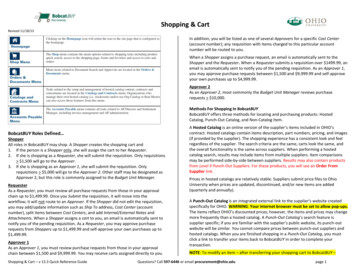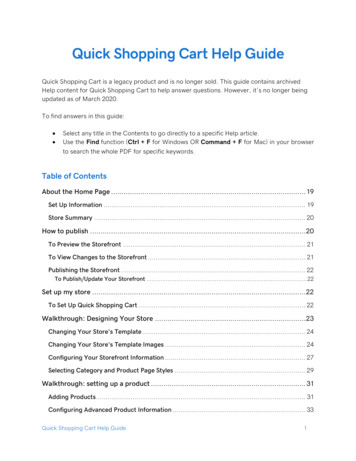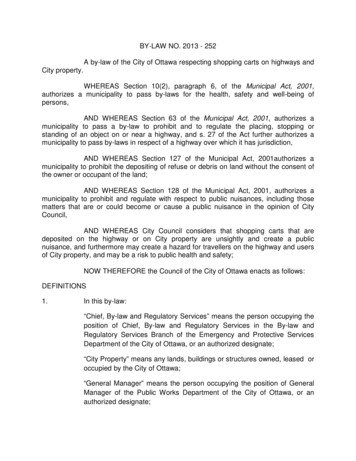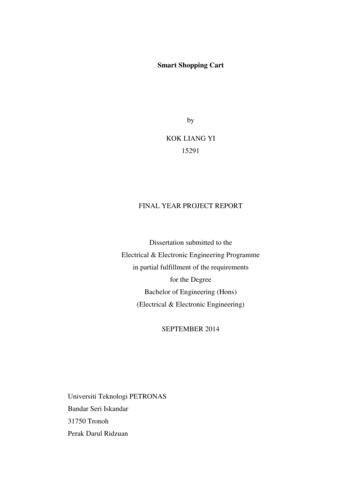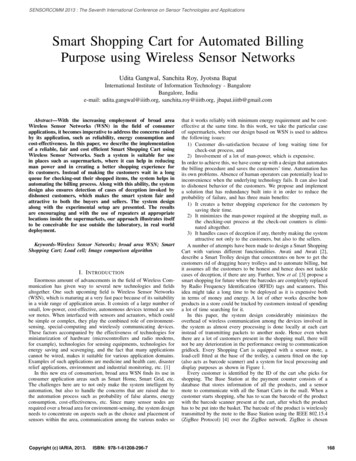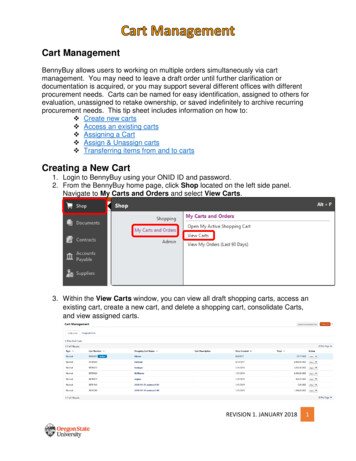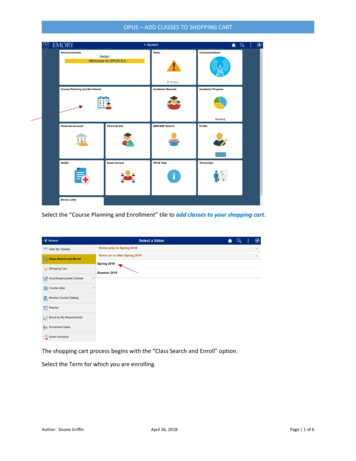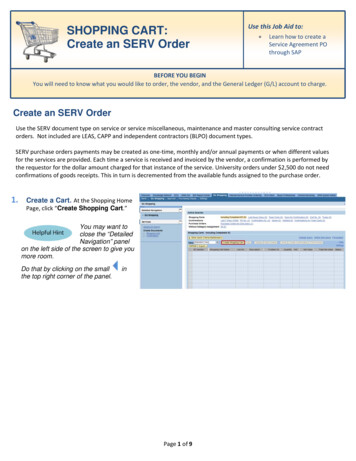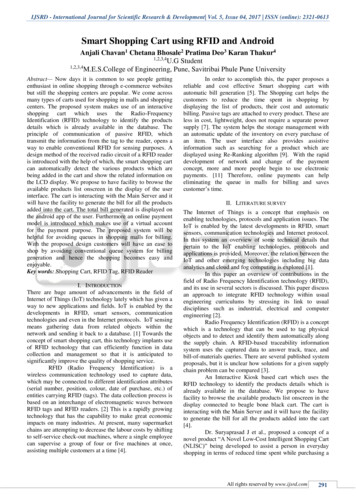
Transcription
IJSRD - International Journal for Scientific Research & Development Vol. 5, Issue 04, 2017 ISSN (online): 2321-0613Smart Shopping Cart using RFID and AndroidAnjali Chavan1 Chetana Bhosale2 Pratima Deo3 Karan Thakur41,2,3,4U.G Student1,2,3,4M.E.S.College of Engineering, Pune, Savitribai Phule Pune UniversityAbstract— Now days it is common to see people gettingenthusiast in online shopping through e-commerce websitesbut still the shopping centers are popular. We come acrossmany types of carts used for shopping in malls and shoppingcenters. The proposed system makes use of an interactiveshopping cart which uses the Radio-FrequencyIdentification (RFID) technology to identify the productsdetails which is already available in the database. Theprinciple of communication of passive RFID, whichtransmit the information from the tag to the reader, opens away to enable conventional RFID for sensing purposes. Adesign method of the received radio circuit of a RFID readeris introduced with the help of which, the smart shopping cartcan automatically detect the various products which arebeing added in the cart and show the related information onthe LCD display. We propose to have facility to browse theavailable products list onscreen in the display of the userinterface. The cart is interacting with the Main Server and itwill have the facility to generate the bill for all the productsadded into the cart. The total bill generated is displayed onthe android app of the user. Furthermore an online paymentmodel is introduced which makes use of a virtual accountfor the payment purpose. The proposed system will behelpful for avoiding queues in shopping malls for billing.With the proposed design customers will have an ease toshop by avoiding conventional queue system for billinggeneration and hence the shopping becomes easy andenjoyable.Key words: Shopping Cart, RFID Tag, RFID ReaderI. INTRODUCTIONThere are huge amount of advancements in the field ofInternet of Things (IoT) technology lately which has given away to new applications and fields. IoT is enabled by thedevelopments in RFID, smart sensors, communicationtechnologies and even in the Internet protocols. IoT sensingmeans gathering data from related objects within thenetwork and sending it back to a database. [1] Towards theconcept of smart shopping cart, this technology implants useof RFID technology that can efficiently function in datacollection and management so that it is anticipated tosignificantly improve the quality of shopping service.RFID (Radio Frequency Identification) is awireless communication technology used to capture data,which may be connected to different identification attributes(serial number, position, colour, date of purchase, etc.) ofentities carrying RFID (tags). The data collection process isbased on an interchange of electromagnetic waves betweenRFID tags and RFID readers. [2] This is a rapidly growingtechnology that has the capability to make great economicimpacts on many industries. At present, many supermarketchains are attempting to decrease the labour costs by shiftingto self-service check-out machines, where a single employeecan supervise a group of four or five machines at once,assisting multiple customers at a time [4].In order to accomplish this, the paper proposes areliable and cost effective Smart shopping cart withautomatic bill generation [5]. The Shopping cart helps thecustomers to reduce the time spent in shopping bydisplaying the list of products, their cost and automaticbilling. Passive tags are attached to every product. These areless in cost, lightweight, does not require a separate powersupply [7]. The system helps the storage management withan automatic update of the inventory on every purchase ofan item. The user interface also provides assistiveinformation such as searching for a product which aredisplayed using Re-Ranking algorithm [9]. With the rapiddevelopment of network and change of the paymentconcept, more and more people begin to use electronicpayments. [11] Therefore, online payments can helpeliminating the queue in malls for billing and savescustomer’s time.II. LITERATURE SURVEYThe Internet of Things is a concept that emphasis onenabling technologies, protocols and application issues. TheIoT is enabled by the latest developments in RFID, smartsensors, communication technologies and Internet protocol.In this system an overview of some technical details thatpertain to the IoT enabling technologies, protocols andapplications is provided. Moreover, the relation between theIoT and other emerging technologies including big dataanalytics and cloud and fog computing is explored [1].In this paper an overview of contributions in thefield of Radio Frequency Identification technology (RFID),and its use in several sectors is discussed. This paper discussan approach to integrate RFID technology within usualengineering curriculums by stressing its link to usualdisciplines such as industrial, electrical and computerengineering [2].Radio Frequency Identification (RFID) is a conceptwhich is a technology that can be used to tag physicalobjects and to detect and identify them automatically alongthe supply chain. A RFID-based traceability informationsystem uses the captured data to answer track, trace, andbill-of-materials queries. There are several published systemproposals, but it is unclear how solutions for a given supplychain problem can be compared [3].An Interactive Kiosk based cart which uses theRFID technology to identify the products details which isalready available in the database. We propose to havefacility to browse the available products list onscreen in thedisplay connected to beagle bone black cart. The cart isinteracting with the Main Server and it will have the facilityto generate the bill for all the products added into the cart[4].Dr. Suryaprasad J et al., proposed a concept of anovel product “A Novel Low-Cost Intelligent Shopping Cart(NLISC)” being developed to assist a person in everydayshopping in terms of reduced time spent while purchasing aAll rights reserved by www.ijsrd.com291
Smart Shopping Cart using RFID and Android(IJSRD/Vol. 5/Issue 04/2017/074)product at the best price available. The main objective ofNLISC is to provide a technology oriented, low-cost, easilyscalable, and rugged system for assisting shopping in person[5].A preliminary development of the smart shoppingcart (SSC) can be integrated into the smart mall system.With the use of radio-frequency identification (RFID) tags,the SSC can automatically detect the various products whichare being added in the cart and show the related informationon the user interface. Finally, the automatic billing servicecan be done by the SSC and the stored shopping data will betransmitted to the cloud server of shopping mall [6].The principle of communication of passive RFIDrelies on the Modulated Scattering Technique (MST) totransmit the information from the tag to the reader, opensaway to enable conventional RFID for sensing purposes,without any additional circuitry. In this paper a shortdescription of the physical principle behind the sensing ispresented along with measurements of RFID tags used forsensing in multiple applications, such as electromagneticfield measurement temperature or presence detection [7].Jianmmg Zhang et al., proposed method of thereceived radio circuit of a Radio Frequency IdentificationWID) reader, which works in the 915MHz ISM frequency.Because the RFID tag uses backscattered modulation signalto communicate with reader, and the back-scattered signalmuch weaker than transmitted signal of the reader, toreceive back-scattered Signal while transmit is the keyproblem. To solve it a multichannel receiver is used [8]A Discriminative Multi-view Interactive Image Reranking (DMINTIR) integrates User Relevance Feedback(URF) capturing users’ intentions and multiple features thatsufficiently describe the images. In DMINTIR,heterogeneous property features are incorporated in tarities [9].Bogdan Boteanu et al., proposed a novelperspective for the diversification problem via RelevanceFeedback (RF).Traditional RF introduces the user in theprocessing loop by harvesting feedback about the relevanceof the search results. This information is used for recomputing a better representation of the data needed [10].Chuanjin Jiang et al., proposed a forward TPP(third party payment, TPP for short) conception, systemarchitecture and payment model and introduces a new TPPpayment solution integrating with modern logistics. Thissolution can prevent the sellers from buyers’ viciouscheating, and make sure the money is received in time. Also,the personal credit mechanism in TPP is discussed to helpthe customer choose the reputable seller [11].III. METHODOLOGYFig. 1: Block DiagramA. Block Diagram DescriptionThe block diagram of the proposed system for the RFIDbased Shopping cart is as shown in the figure. It consists oftwo sections one is Shopping cart section and another isServer section. We intend to replace the existing barcodetechnology by RFID technology. It has got many advantageslike long read range, faster scanning, and higher durability,highly secured as comparedto that of barcodeReader. For instance if we compare the speed of them,reading two barcode tags will take one minute where as inone minute we can read almost 40 RFID tags. For readingRFID tags line of sight is not required. They can berewritable and has a greater life span. So because of all theseadvantages we prefer using RFID technology. In theproposed system, each RFID tag is attached to respectiveproducts and when RFID Reader reads the RFID tag thisinformation is transmitted to the server (database getsupdated from the server continuously which is controlled bysystem Admin). The tag information is compared with dataavailable. If it is present in the database, it displays productdetails like name of the product, cost, and total amount ofbill to be paid. As soon as the product is added into the cart,the total cost is also updated at the same time. This processwill be repeated till end of shopping. In the end, the total billis displayed on the LCD screen of the shopping cart andthey need to press the upload key in order to send data to theserver. This total billing information of a particular cart willbe transmitted to server side using RF module. User candirectly proceed to online payment provided in the App aftershopping. As we know, in Mega marts and Shopping places,there will be many trolleys or carts. In order to avoidconflicts as such, each Cart as well as the tags are assignedwith unique Id, thus providing security and a faster shoppinginfrastructure.B. Hardware Components1) RFID tagRFID tag is made up of three compositions such as antenna,encapsulation and transceiver. There are two types such asActive RFID tags and Passive RFID tags. In Active RFIDtags, a battery source is required where as in passive typeRFID tags it is not required [7]. In the proposed system weare using Passive RFID tags which will operate at very lowfrequency of l25Khz.All rights reserved by www.ijsrd.com292
Smart Shopping Cart using RFID and Android(IJSRD/Vol. 5/Issue 04/2017/074)Fig. 2: RFID Tag2) RFID ReaderWe have used RFID Reader which uses 5V regulated powersupply in this system for its operation [8]. When RFIDReader is turned on then it transmits electromagnetic signalsto RFID tag which are received by RFID tags. All thescanned tag information is stored in the Atmega16 microcontroller. It can scan multiple tags at a time within itsproximity.Fig. 3: RFID Reader3) RF moduleIn the proposed system we are using a RF module at theShopping cart in order to be connected with the server. Eachtag is also provided with unique ID. The received RFID tagnumber from RF is maintained in the database. It is thencompared with database, if it is present in the database thenProduct details like Cost, manufacturing Year and Name ofthe Product is displayed and at the end Total Billinformation is displayed, that is Number of Productspurchased and Total cost. The web portal is maintained atthe server and being accessed from the cart. User can paythe bill amount and leave the counter without waiting in bigqueue for scanning.C. Boyer-Moore-Horpool AlgorithmIn computer science, the Boyer—Moore—Horspoolalgorithm or Horspool's algorithm is an algorithm forfinding substrings in strings. The algorithm trades space fortime in order to obtain an average-case complexity of O(n)on random text, although it has O(nm) in the worst case,where the length of the pattern is m and the length of thesearch string is n.Boyer—Moore—Horspool preprocesses the patternto produce a table containing, for each symbol in thealphabet, the number of characters that can safely beskipped. The preprocessing phase, in pseudo code, is asfollows:function preprocess(pattern)T — new table of 256 integersfor i from 0 to 256 exclusiveT[i] — length(pattern)for i from 0 to length(pattern) - 1 exclusiveT[pattern[i]] — length(pattern)-1 -ireturn TPattern search proceeds as follows, the procedure searchreports the index of the firstoccurrence of needle in haystack.function search(needle, haystack)T — preprocess(needle)skip — 0while length(haystack) - skip 2 length(needle)i — length(needle)-1while haystack[skip i] needle[i]ifi 0return skipi «— i-1skip — skip T[haystack[skip length(needle) - 1]]return not-found1) PerformanceThe algorithm performs best with long needle strings, whenit consistently hits a non-matching character at or near thefinal byte of the current position in the haystack and thefinal byte of the needle does not occur elsewhere within theneedle. For instance a 32 byte needle ending in "z"searching through a 255 byte haystack which does not havea '2' byte in it would take up to 224 byte comparisons.The worst case behavior happens when the badcharacter skip is consistently low (with the lower limit of 1byte movement) and a large portion of the needle matchesthe haystack. The bad character skip is only low, on a partialmatch, when the final character of the needle also occurselsewhere within the needle, with 1 byte movementhappening when the same byte is in both of the last twopositions.Fig. 4: RF Transmitter and Receiver Module4) Atmega16 Micro-controllerThe proposed system makes use of high performance, lowpower Atmel AVR 8-bit microcontroller. The Atmega16 is alow-power CMOS 8-bit microcontroller based on the AVRenhanced RISC architecture. The device is manufacturedusing Atmel’s high density non-volatile memorytechnology.Fig. 5:All rights reserved by www.ijsrd.com293
Smart Shopping Cart using RFID and Android(IJSRD/Vol. 5/Issue 04/2017/074)Idea of Horspool is that, instead of the "badcharacter" that caused the mismatch, in each case therightmost character of the current text window is used fordetermining the shift distance. Hence this algorithm is usedby the user to browsing the product on the mobileapplication. Hence the user gets to search wide range ofproducts in the mall and also its details on mobile itself.D. Workingtransmitted from Shopping Cart to main Server forverification using RF module in that payment zone. Throughwireless network, the cart will be connected with the MainServer always. We are using the internet to access the serverand web page. For an individual user, a virtual walletaccount is provided for the online payment and the customercan pay the bill directly by a deducting it from thebalance.[11]This comes with two ways to bucket yourmoney to save and then spend. In case if the balancebecomes null, the customer has to inform the Admin aboutthe same and get the wallet recharged from him.E. ApplicationsThe Smart Shopping Cart is suitable for customers tobrowse the product details and then shop. The future of theproposed system is very bright and progressive as it helpscost savings and efficient management.1) Proposed system can be used at airports because of itswireless nature and its ability to ensure better security.2) With the advent of technology, these Smart cart will beeventually replacing salesmen, hence helping inreducing final product of goods. As a result, better andmore profit margin for the shop but with a danger ofmore promoters and sales men losing the job.3) We can also do the global sales monitoring andinventory.IV. RESULTFig. 5: Flow Diagram of the proposed SystemThe Hardware Implementation of the proposed prototypeuses hardware equipment's such as AVR Atmega16, RFmodule, RFID Reader, RFID tags, LCD display, etc. Theproposed system comprises dedicated Android applicationwhich will list all the items available in the shop for thecustomers. A database has been created which will have allthe product details. Customer has the facility to access theapplication to browse the product details, price etc. for allproducts before actually seeing that product. The mostrelevant product is first displayed to the user due to theBooyer-Moore-Horspool algorithm.[9]The RFID tag isattached to each product and each RFID tag have a uniquenumber, these numbers are retrieved from the database.Every time customer picks & put the product into the cart orkeeps the product out of the cart, the product gets added ordeleted from the bill automatically. Final bill will begenerated when the customer finalizes his shopping. The billwill be verified by the admin and once admin givespermission, the customer can go ahead with the payment.We are proposing here a special zone for the sake ofpayment. As we need to make sure once the customergenerates the bill, he should not have access to add productwithout admin’s permission. This is to ensure that thecustomers do not add any product after the bill generation.Hence we propose here for a special zone near the billingcounter and near exit for the bill generation zone. Thatmeans inside the mall they can generate the bill but cannotproceed with the payment and can pay only in that networkcreated for the same purpose. Total bill information isSmart shopping cart is designed for commercial use.Automatic generation of bill and the online paymentseliminates the queues and attests a replacement for thepresent barcode systems. Some system uses Active tags forstoring the details of each product which are unaffordablefor a Shopping mall as there are thousands of products. Alsoan active tag is powered by an on-board battery, whereasPassive tags are powered by the electromagnetic wavesemitted by the reader. Traditional practice of standing in along queue to scan all your products through a barcodescanner and then paying the bill is eliminated. The trend ofcashless payments is taken into consideration and theconcept of Virtual wallet is promoted. Virtual wallet henceallows us to pay the bill by deducting it from current balanceand recharge it anytime from the Admin.The Boyer-Moore-Horspool algorithm is used forfaster retrieval of the searched product which is easy toimplement and efficient for small alphabet. It is lesscomplicated than the Boyer-Moore algorithm as it searchesthe substring in a string. Boyer-Moore-Horspool uses onlythe bad character shift. Hence, the best case of searching apattern in the text is O(n) unlike the Boyer-Moore, O(n/m).So the user can browse the products in the mall at a fasterrate and a filtered result is provided. Thus, Smart shoppingcart is the system which is proficient, time-saving, enduringand will give promising results.V. CONCLUSIONSThe fun of shopping in the Shopping centers and ShoppingMalls can never ever fade. Thus the proposed Shopping cartwill be fun and friendly for the customers for the shopping.The proposed design incorporates the customer friendlynature with advanced features in it. The proposed systemwill make shopping experience more exciting. With theAll rights reserved by www.ijsrd.com294
Smart Shopping Cart using RFID and Android(IJSRD/Vol. 5/Issue 04/2017/074)proposed based Shopping cart system we can avoid longqueues and thus saves customer time by avoiding unwantedtime during scanning of each individual product at thebilling counter. The Android application can help the user tosearch for a particular product inside that mall by providingall the details of its products. Using Booyer-MooreHorspool algorithm the best products are displayed to thecustomer. Online payment further reduces another queue forbill payment. Hence, providing a faster shoppingexperience. Also with slight modifications, this system canbe used in various other different fields and places.for Social Image Search Result Diversification”, 978-14673-6870-4/15/ 31.00 2015 IEEE[10] Jun Li, Chang Xu, Wankou Yang, Changyin Sun andDacheng Tao, Fellow, “Discriminative Multi-viewInteractive Image Re-ranking”, IEEE Transactions onImage Processing, JOURNAL OF L ATEX CLASSFILES, VOL. 14, NO. 8, AUGUST 2015,10.1109/TIP.2017.2651379[11] ChuanjinJiang,Wenguan Song, “An Online Third PartyPayment Framework in E-commerce “, 978-1-42445848-6/10/ 26.00 2010 IEEE.ACKNOWLEDGEMENTWe would like to thank The Principal Dr. A. A. Keste forproviding us the opportunity to work on this project. Wewould like to show our sincere gratitude to our guide Prof. S.B. Shinde for his guidance and idea without which thispaper would not be complete. He provided us the importantidea which helped is to accomplish writing this paper. Weare also thankful to our HOD Dr. Mrs. N.F. ShaikhDepartment of Computer Engineering for her constantencouragement and support.REFERENCES[1] Ala Al-Fuqaha, Mohsen Guizani, Mehdi Mohammadi,Mohammed Aledhari, MoussaAyyash, “Internet ofThings: A Survey on Enabling Technologies, Protocolsand Applications “IEEE Communications Surveys &Tutorials, 10.1109/COMST.2015.2444095 (2015)[2] Fatah Chetouane, “An Overview on RFID TechnologyInstruction and Application”, 2015, IFAC(International Federation of Automatic Control)10.1016/j.ifacol.2015.06.111[3] Miguel L. Pardal and Jos eAlves Marques,”Cost Modelfor RFID-based Traceability Information Systems”,978-1-4577-0027-9/11/ 26.00 2011 IEEE[4] J C.Narayana Swamy ,Dr. D Seshachalam, ”SmartRFID based Interactive Kiosk Cart using wirelesssensor node”, 2016 International Conference onComputational Systems and Information Systems forSustainable Solutions[5] Dr.Suryaprasad J, Praveen Kumar B O, Roopa D&Arjun A K, “A Novel Low-Cost Intelligent ShoppingCart”, 978-1-4673-0498-6/11/ 26.00 2011 IEEE[6] Hsin-Han Chiang, Wan-Ting You, Shu-Hsuan Lin,Wei-Chih Shih,”Development of Smart Shopping Cartswith Customer-Oriented Service” 2016 InternationalConference on System Science and Engineering(ICSSE) National Chi Nan University.[7] S. Capdevila, L. Jofre, J. Romeu ,J.C. Bolomey,”Passive RFID based sensing”, 2011 IEEE InternationalConference on RFID-Technologies and Applications,978-1-4577-0027-9/11/ 26.00 2011 IEEE[8] Jianmmg Zhang, ZemingXie, ShengliLai.ZehaiWu,”ADesign of RF Receiving Circuit of WID Reader”, 20044 ' International Conference on Microwave andMillimeter Wave Technology Proceedings, 0-78038401 -6/04/ 20.00 02004 IEEE[9] BogdanBoteanu, Ionu tMironic a, BogdanIonescu,”Hierarchical Clustering Pseudo-Relevance FeedbackAll rights reserved by www.ijsrd.com295
concept of smart shopping cart, this technology implants use of RFID technology that can efficiently function in data collection and management so that it is anticipated to significantly improve the quality of shopping service. RFID (Radio Frequency Identification) is a wireless communication technology used to capture data, .
